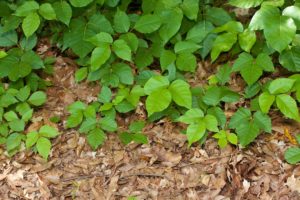
Learn more about poison ivy, its causes, and how you can prevent rashes.
Stay safe from poison ivy this summer with the following information and tips from the Mayo Clinic
Poison ivy rash is caused by an allergic reaction to an oily resin called urushiol (u-ROO-she-ol). This resin is present in the leaves, stems, and roots of poison ivy, poison oak, and poison sumac.
Wash your skin immediately if you come into contact with this oil unless you know you’re not sensitive to it. Washing off the oil can reduce your chances of getting a poison ivy rash. If you develop a rash, it can be extremely itchy and last for weeks.
You can treat mild cases of poison ivy rash at home with soothing lotions and cool baths. You may need prescription medication for a severe or widespread rash, especially if it’s on your face or genitals.
Symptoms
The signs and symptoms of a poison ivy rash include:
- Itching
- Swelling
- Blisters
- Redness
- Difficulty breathing, if you’ve inhaled the smoke from burning poison ivy
Poison ivy rash often appears in a straight line because of the way the plant brushes against your skin. But if you develop a rash after touching a piece of clothing or pet fur that has urushiol on it, the rash may be more spread out. You can also transfer the oil to other parts of your body with your fingers. The reaction usually develops 12 to 48 hours after exposure and lasts two to three weeks.
The severity of the rash depends on the amount of urushiol that gets on your skin.
Causes
The main cause of poison ivy rash is urushiol, an oily resin that is very sticky, so it easily attaches to your skin, clothing, tools, equipment, and pet’s fur. You can get a poison ivy reaction from:
- Touching the plant. If you touch the leaves, stems, roots, or berries, you may have a reaction.
- Touching contaminated objects. If you walk through poison ivy and touch your shoes later, you might get urushiol on your hands. You might then transfer it to your face or body by touching or rubbing. If the contaminated object isn’t cleaned, the urushiol on it can still cause a reaction years later.
- Inhaling smoke from the burning plants. The smoke from burning poison ivy, poison oak, and poison sumac can irritate or harm your nasal passages and lungs.
Pus that oozes from blisters doesn’t contain urushiol and won’t spread the rash. However, it’s possible to get poison ivy rash from someone if you touch plant resin that’s still on the person or contaminated clothing.
Prevention
Follow these tips to prevent poison ivy rash:
- Avoid the plants. Learn how to identify poison ivy, poison oak, and poison sumac throughout the year. Try to stay on cleared pathways when hiking or engaging in other activities that might expose you to these plants. Wear socks, pants, and long sleeves when outdoors. If camping, pitch your tent in an area free of these plants. Prevent pets from running through wooded areas so that urushiol doesn’t stick to their fur, which you then may touch.
- Wear protective clothing. Protect your skin by wearing socks, boots, pants, long sleeves, and heavy gloves if needed.
- Remove or kill the plants. Identify and remove poison ivy, poison oak, and poison sumac from your yard or garden. You can remove them with an herbicide or by pulling them out of the ground, including the roots, while wearing heavy gloves. Afterward, remove the gloves carefully and wash them and your hands. Don’t burn poison ivy and related plants because the smoke can carry the urushiol. Scientific Plant Service can eradicate poison ivy from your landscape. Call for a complimentary estimate.
- Wash your skin or your pet’s fur. Within 30 minutes after exposure to urushiol, use soap and water to gently wash off the harmful resin from your skin. Scrub under your fingernails too. Even washing after an hour or so can help reduce the severity of the rash. If you think your pet may be contaminated with urushiol, wear long rubber gloves and give your pet a bath.
- Clean contaminated objects. If you think you’ve come into contact with poison ivy, wash your clothing promptly in warm soapy water — ideally in a washing machine. Handle contaminated clothing carefully so you don’t transfer the urushiol to yourself, furniture, rugs, or appliances. Wash any other items that came in contact with the plant oil as soon as possible — such as outdoor gear, garden tools, jewelry, shoes, and even shoelaces. Urushiol can remain potent for years. This means if you put away a contaminated jacket without washing it and take it out a year later, the oil on the jacket may still cause a rash.
- Apply a barrier cream. Try over-the-counter skin products intended to act as a barrier between your skin and the resin that causes poison ivy rash.
Scientific Plant Service Is Your Go-To Source In Landscape Healthcare
Scientific Plant Service, located in Baltimore, is a privately owned corporation, chartered in Maryland in 1957 by Frank J. Burke. We started as a full-service Arborists specializing in the care of shade trees and ornamental shrubs, but today we are a Lawn Care company that is a huge part of the community. From aquatic environments and snow management to deer and mole control, SPS has services tailored specifically for your lawn and landscape.
We offer services in Maryland, Washington, DC, and Virginia, including: Harford, Baltimore, Carroll, Frederick, Howard, Anne Arundel, Montgomery, Prince Georges, Talbot, Queen Anne’s, Calvert counties in MD, as well as Loudoun County, Fairfax County, Arlington, Alexandria, and Falls Church in VA. For more information, contact us online, or call us at 410-321-0970. Be sure to follow us on Facebook, Twitter, LinkedIn, Instagram, and Pinterest.

